DAY1 : AIRPORT – HA NOI – HA LONG :

Pick up at the airport a.m then transfer to Ha Noi for lunch. After lunch visit the Temple of Literature “ The Temple of Literature was constructed in 1070, first to honor Confucius and In 1076, King Ly Nhan Tong built Quoc Tu Giam as the first university of Vietnam . nowadays the temple of literature is the place to celebrate the doctorates and high rank scholars of Vietnam ·
The temple is divided into five court yard, each with its own significance and history ·. There are a total of 82 tombstones, with names and origins of 1307 doctors, corresponding to 82 examination courses from 1442 to 1779. If you visit the temple at the beginning of the year or in May when many important examinations take place, you will catch sights of numerous students who come and rub the tortoise head. Such an act is believed to bring them luck to pass the test. If you are keen on architecture, Temple of literature has one of the most typical architecture style for centuries in Vietnam, composed of wood and tiles. Along the pass way is hundred-year-old trees that have witnessed ups and downs of history ·”
Continne to Ha Long dinner at local restaurant .
Over night in MIRTHIN/ ASEAN / PEARL 4*
Lunch : SEN RESTAURANT
Dinner : MAGOLIA RESTAURANT
DAY 2 : HA LONG :
Aftet breakfast take a boat trip to visit Ha Long bay – world natural hertiage to visit Sung Sot cave, Gà Chọi island, Titop . See Ha Long water puppet show ( Traditional content of water puppet performance like daily life of Vietnamese farmers (cultivating, tending buffalo, catching fishes…), communal entertainment (swimming contest, dragon dancing…), or historical legends (Le Loi returns precious sword…), with modest performance way have appealed audiences for centuries. However, the artists of Royal Halong Water Puppet Theater want to renew the old puppet shows with effect of light, music and combination between people and puppets. )
Dinner then transfer hotel to check in. Over night in MIRTHIN/ ASEAN / PEARL 4*
Lunch on board
Dinner : PEARL HOTEL

Sung Sot Cave, which means Cave of Surprises, is the biggest and finest cave in Halong Bay. It actually got its name from the French, who called it grotte des surprises, or grotto of surprises. It is located on Bo Hon Island, near the centre of Halong Bay, within the vicinity of other sights such as Titov Island, Bo Nau Grotto, Me Cung Cave and Luun Grotto. There is a small pier where boats dock to allow visitors down. From the pier, a flight of 50 stone steps takes one to the entrance of the cave. The inside of Sung Sot Cave is simply cavernous. At many places the ceiling is low, and takes on a wavy appearance. A profusion of stalactites and stalagmites cover the walls.
To ensure the safety of visitors, a path is built to zigzag through Sung Sot Cave. Guide ropes help to keep visitors on the path Multi-coloured lights are also installed to beautify the cave and bring out its grandeur. Coming out of the cave, visitors get a panoramic view of Bo Hon Bay below. It is one of those iconic view of Halong Bay that has appeared in many postcards.
Ga Choi Island
As one of the famous islands in Ha Long Bay, Ga Choi Islet (or sometimes called Hon Trong Mai) located near Dinh Huong island in the southwest of the Gulf, from the Bai Chay Tourist Wharf around 5 km. This is a cluster of two islands shaped like a pair of chickens, a blank one roof, with a height of over 10 meters with the pounding feet are protruding posture. Logo is a symbol of Ha Long Bay, Ga Choi Islet is also a symbol of tourist guidebooks Vietnam in general.
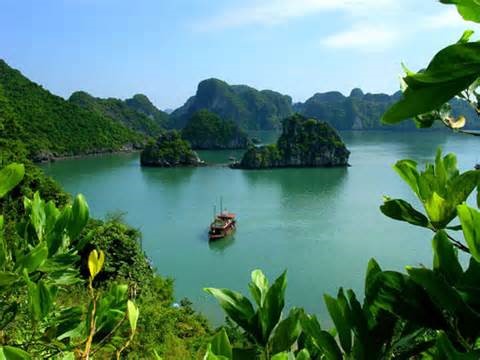 Ti Top Island
Ti Top Island
Ti Top Island, named after French colonial islands Cat Nang, located on the Halong Bay area about 14 km from Bai Chay east. Ti Top island named after Ho Chi Minh visited Halong Bay with astronaut Gherman Titov Russian, in 1962 [22]. Ti Top island with steep slopes and flat-shaped white sand beach at the foot of the moon. The boat tour on the island often had to tourists climbing ashore panoramic Gulf, swimming, boating kay-battery, pull buoys and parachuting.
DAY 3 : HA LONG – NINH BINH ( TRANG AN )- HA NOI :
Morning take guests to Ninh Binh to visit Trang An ( Trang An is an eco resort located in the World Heritage population Trang An Ninh Binh province. It was the Government of Vietnam national relic is particularly important and is a UNESCO world heritage site since 2014. Trang An dual called the Southern capital of Hoa Lu ancient capital, is now trying Hoa Lu ancient capital. Trang An with limestone mountain system with geological age about 250 million years, weathering over long periods by the transformation of the earth, climate, transgression, marine degradation has brought in hundreds of valleys, caves dynamic, lakes and marshes. In this landscape, there are many wetland ecosystems, forests and limestone monument linked to the history of the ancient capital of Hoa Lu.
Contact Trang An scenic area – Tam Coc – Hoa Lu is currently the general planning on scenic Trang An population, which is a world heritage first mixture in Vietnam with the outstanding value of the landscape natural, cultural and historical geological formations and is also famous for being the investment to become a resort of international stature
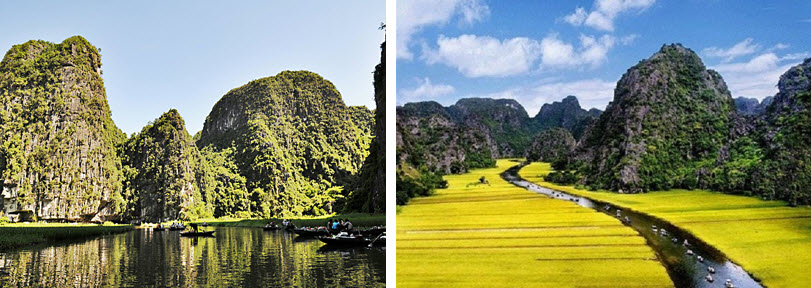
Dia Linh cave :
Dia Linh cave is the first destination in the journey comes from Sao Khe river marina. Hang aka Precious hang because here visitors will feel lost in the treasure of fossil stone. Out of the mouth of the cave is a charming painted marine scenes of clouds, mountains and rivers. 260 m long cave with stalactites hang down more magical
Beyond the Dia Linh Cave, visitors continue to Toi cave. In very dark cave, must carry flashlights to see the cave. 315m long cave, the cave has many stalactites with different shapes. The temperature in this cave is often higher than 2-3 degrees Celsius outside, because the heart of the cave with a hot water circuit … Up next cave, visitors Sang cave. This cave is short, only about 100m, so the cave always receive light from entering the two shops.

Ba Giot Cave
Ba Giot cave with stalactites more colorful appearance. There are types of tree mallow grows regularly called upside-down from the ceiling. A special feature is the Ba Giot cave stalactites in caves does not dry as before which was wet and continue to transform, forming new shapes and new shade …
Sinh Cave, Si Cave and Ba Giot cave associated with the legend of a sad love story. Old had dudes love her dearly a princess. As wedding presents guy to hang Sinh burden to suitors, she was tribute to the neighboring country. Ba Giot cave him into a bath, then hugged his blocks in the cave sediments own situation Si.
Legend has anyone come across the Ba Giot cave of which picked up three small water drops from stalactites on the palms will be lucky in life and happiness in love.
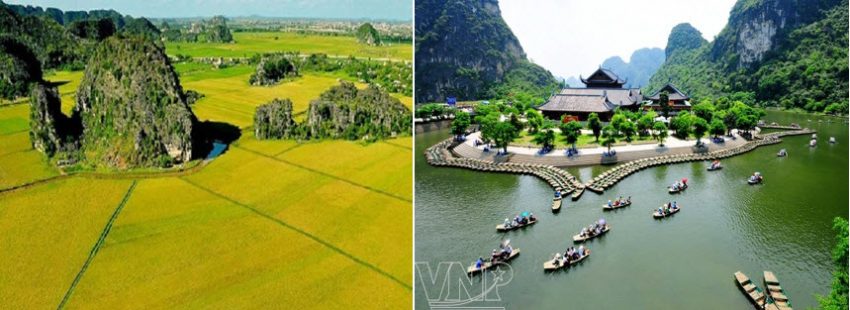
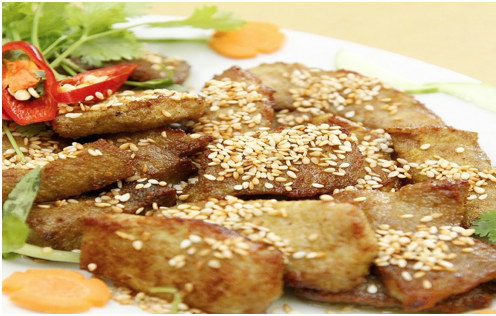 During this trip, often people do not miss the opportunity to enjoy the mountain goat meat, Ninh Binh regional specialties. Goats are farmed naturally on the mountain, forest food crops, the meat is delicious.
During this trip, often people do not miss the opportunity to enjoy the mountain goat meat, Ninh Binh regional specialties. Goats are farmed naturally on the mountain, forest food crops, the meat is delicious.
Trang An visit, tourists are themselves in nature and will look forward to come back here when possible.
Transfer back to Ha noi visit to Hoan Kiem Lake (Hoan Kiem Lake means “Lake of the Returned Sword”. The lake is the heart of Ha Noi capital. There is a legend about the name of this lake The lake is considered the center of Hanoi, not only physically but also symbolically. In fact, the more you spend time learning about the lake, the more special it becomes)
The old quarter : Located in the middle of Ha Noi, the Old Quarter with its old-styled narrow streets full of antique brick houses seems to resist the flow of time while still actively trying to adapt to the dynamic atmosphere of the modern city
Ha Noi Old Quarter consists of many small, busy streets, each bears the name of the goods that was specifically traded there such as Hang Bac (Silver Product), Hang Ma (Paper Product), Hang Go (Wood Product) Visiting this unique historical vestige, tourists get lost in a totally different world from the rest of the city and have the chance to explore the energetic life of the local a hundred years ago, where there were no high-rise buildings, too much traffic; things will get a little bit smaller, as visitors may have used to those skyscrapers and shopping centers in other parts of the city, but not at all less lively and vigorous·
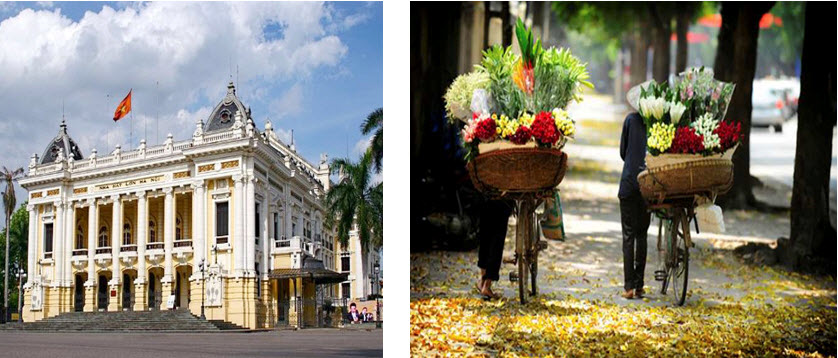
Tran Quoc Pagoda : Tran Quoc Pagoda is located beside West Lake – the biggest lake in Ha Noi, and on Thanh Nien Road – the most romantic road of the capital. The pagoda was constructed in 541 and was completed in 545 under its original name of Khai Quoc (National Founder). It has 1500- year history. Visiting Tran Quoc pagoda can give visitors an insight in the religion life and culture of Vietnamese people – a religious relic with a spectacular ¬surrounding scenery
Over night in River Side/ Muong Thanh Center / Thang Loi 4*
Lunch : TAM COC RESTAURANT
Dinner : LAKE SIDE HOTEL
DAY 4 : HA NOI- DA NANG :
Tranfer to airport take domestic fly to Da Nang City visit Cham Museum, Ngu Hanh Son, Hoi An city ( Hoi An cyclo
Phuc Kien Assembly Hall , Japanese bridge )

Danang City is located in the middle of the country, traffic axis north – south road, rail, sea and air, 764km from Hanoi to the north, the city of Ho Chi Minh 964 km south. Therefore, to Danang is easy, the problem is to choose what vehicles for the trip.
Blessed Danang is located between three neighboring world cultural heritage: Hue, Hoi An ancient town and My Son Sanctuary, the position was in the role of cities in Da Nang area, which is welcome, catering, hotel transfer. Not only is the heart of the World Heritage 03, Da Nang city has many beautiful landscapes that visitors can hardly forget after visiting this city.
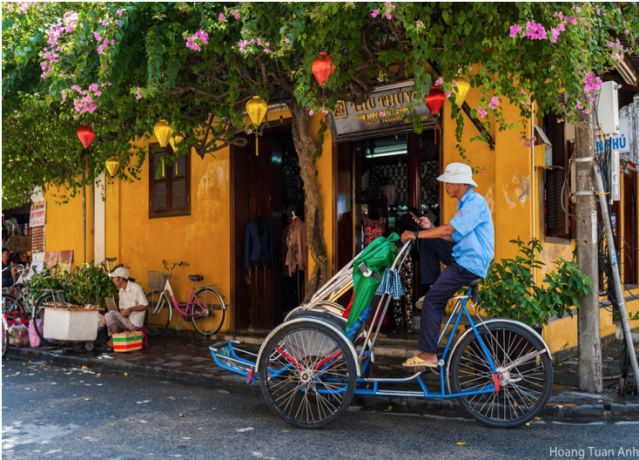 Danang Hai Van Pass steep, rugged, dubbed “People are most important heroes.” There is Son Tra Peninsula is an ideal meeting point for guests. Son Tra foot of a rocky mountain, Bai But, Bai Rang, Bai Bac, Bai Nom … interesting guests feel as immersed in the splendor of the sunrise and sunset of a quietly charming region. Eco-tourism resort Ba Na – Suoi Mo many people as Dalat, Sapa of Central. There is the legendary Marble Mountains, “Nam Thien wins”.
Danang Hai Van Pass steep, rugged, dubbed “People are most important heroes.” There is Son Tra Peninsula is an ideal meeting point for guests. Son Tra foot of a rocky mountain, Bai But, Bai Rang, Bai Bac, Bai Nom … interesting guests feel as immersed in the splendor of the sunrise and sunset of a quietly charming region. Eco-tourism resort Ba Na – Suoi Mo many people as Dalat, Sapa of Central. There is the legendary Marble Mountains, “Nam Thien wins”.
In Danang, can not fail to mention the Han River and Han River Bridge – the first bridge in Vietnam rotation – the pride of the people of the city. Han River Bridge is a symbol of new life, a desire to go to the city was built with the contribution of all citizens. It seems all the poetic beauty of the Han River is only one perfectly exposed in the space of the Han River Bridge windy and cool. Han River Bridge is not only creating more favorable conditions for transportation, tourism, stimulate economic potential of a large area in the east of the city but also a cultural imprint of Da Nang today sent forever for posterity.
Sea also inspired endless travel that Danang is. Besides the beaches clean and beautiful stretches, Da Nang Port is one of the busiest ports in Vietnam today.
Da Nang city on the Han River, the beautiful coastal city of dreaming and hospitality of the people of the city have made it a frequent destination of tourists in the country and internationally.

Museum of Cham Sculpture is a museum showcasing artifacts scale Cham in Vietnam, under the Da Nang Museum. This is the museum built by the French, specialized collection, storage and display of relics of sculpture of Champa kingdom found in the towers, ramparts Care in South Central coastal provinces from Ha Tinh to Binh Thuan and Tay Nguyen provinces.

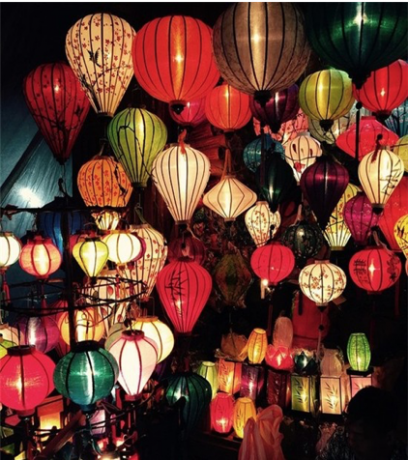 Ngu Hanh Son or Non Nuoc Mountain is the generic name for a scenic limestone mountains 5 knob on a sandy beaches, over an area of approximately 2 km2, including: Kim Son, Moc Son, Thuy Son (large, high and most beautiful), Vulcan (two tops) and Tho Son, located downtown Da Nang approximately 8 km to the southeast, on the route Da Nang – Hoi An; now in Hoa Hai ward, Ngu Hanh Son District, Da Nang City, Vietnam.
Ngu Hanh Son or Non Nuoc Mountain is the generic name for a scenic limestone mountains 5 knob on a sandy beaches, over an area of approximately 2 km2, including: Kim Son, Moc Son, Thuy Son (large, high and most beautiful), Vulcan (two tops) and Tho Son, located downtown Da Nang approximately 8 km to the southeast, on the route Da Nang – Hoi An; now in Hoa Hai ward, Ngu Hanh Son District, Da Nang City, Vietnam.
Phuc Kien Assembly Hall is home to Tin Hau Holy Mother Church and the protective deity of water, money, children, the ancestors and the meeting place of compatriot and mutual assistance from Fujian, who Hoi An to the earliest and largest. This is a typical architecture in Hoi An was built in 1697. After many years of restoration, with the contribution of overseas Chinese state of Fujian Assembly Hall became more brilliant, spacious contribute embellishment urban architecture of Hoi An.

This is the only bridge neck of New York, according to records, this is the bridge due to the Japanese businessmen built to facilitate travel and trade between Chinatown and the Japanese city. With a length of 18m spanning a creek separating the two streets, Tran Phu and Nguyen Thi Minh Khai. Because the bridge has a shrine to the people often called Bridge but it also has another name that’s also quite popular Japanese Bridge because according to legend, monster Mamazu whose head was in Japan, the tail in the Indian Ocean and then in Vietnam itself, whenever squirmed will cause earthquakes, natural disasters, floods. So the Japanese have built bridges with the Spirit and the Spirit Dog object to prop monster town.
 Over night at MUONG THANH HOI AN
Over night at MUONG THANH HOI AN
Lunch : KIM DO DA NANG RESTAURANT
Dinner : PHO HOI RESTAURANT
DAY 5 : HOI AN- MY SON- HUE :
After breakfast at hotel, T/G take guest to My Son visit My Son Sanctuary
My Son Sanctuary of Duy Phu commune, Duy Xuyen district, Quang Nam, Da Nang City and about 69 km from Tra Kieu Citadel about 20 km, is comprised of many Champa temples, in a valley about 2 km in diameter, surrounded by hills. This used to be the organization’s sacrifice Champa dynasty, as well as the tomb of Champa kings or princes, like the country. My Son Sanctuary is considered one of the centers of the main temples of Hinduism in Southeast Asia and is a unique heritage of its kind in Vietnam.
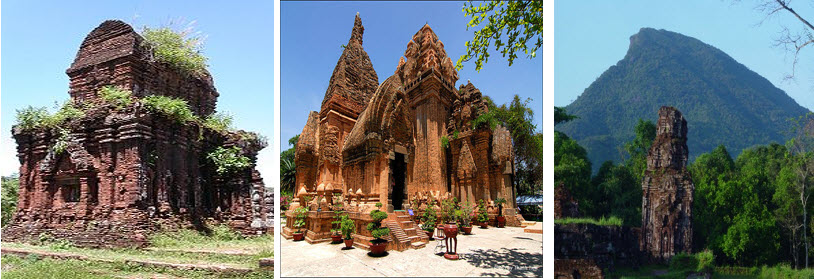
Then back to Hue city Thien Mu Pagoda, Forbidden City, Khai Dinh Tomb , Huong River
Huế is a city in central Vietnam that was the seat of Nguyen Dynasty emperors and the national capital from 1802-1945. A major attraction is its vast, 19th-century Citadel, surrounded by a moat and thick stone walls. It encompasses the Imperial City, with palaces and shrines; the Forbidden Purple City, once the emperor’s home; and a replica of the Royal Theater.
Thien Mu Pagoda (? 天姥), also known as Linh Mu Pagoda is an ancient temple situated on Ha Khe Hill, the left bank of the river, away from the center of Hue City (Vietnam) about 5 km to the west. Thien Mu Pagoda officially started up in New Buffalo (1601), Princess Tien Nguyen Hoang Nguyen Lords first taste in Cochin.
Citadel is within Monday inside the Hue Citadel, which functions to protect the most important palaces of the court, the ancestral shrine Nguy and protect the Forbidden City – the place reserved for kings and royal . It is often referred to Citadel and the Forbidden City is the Citadel.
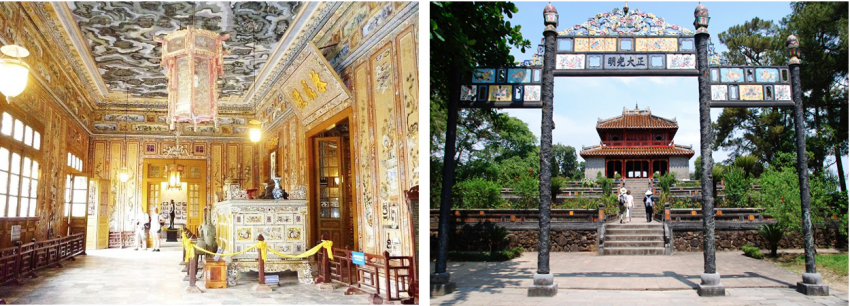
Khai Dinh Tomb, also known as Application Lang (應 陵) is the tomb of King Khai Dinh (1885-1925), the 12th king of the Nguyen Dynasty, located on a mountainside Chau Chu (also called Chau E) outside Hue citadel, this Thuy Bang commune, Huong Thuy town.

Khai Dinh Tomb of architecture which were later often put off traditional architectural lines of Nguyen by the new, the unusual, the unique, the extravagant welcome, inept … created from architectural styles.
Overall, the steering is a rectangular block of high-rise with 127 steps. The entry of many schools of architecture such as Hinduism, Buddhism, Roman, Gothique … has left its mark on the specific works:
These cylindrical pyramid port architecture influence from India;
Head said Stoupa form of Buddhism;
Barriers such as the crucifix spindly;
Beer house with octagonal columns and Roman arches exit door variant …
This is the result of two factors: the intercultural East – West at the intersection of history and personality of Khai Dinh.
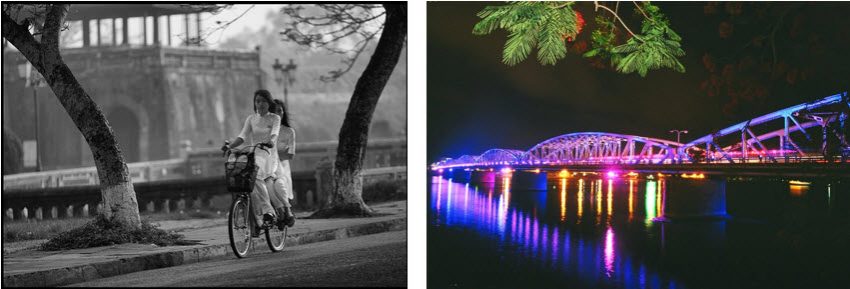
Also Hue is also famous for the special dishes: bun bo hue, high floor cake ( bánh cao lầu ) , tea games ( các loại chè bắp ) commercials noodles ( mỳ quảng ) ….. and with graceful Ao Dai made features separately in Hue.
Over night at CHERISH HUE
Lunch : TAU BA LOC RESTAURANT
Dinner : CUNG ĐINH HUE RESTAURANT
DAY 6 : HUE – DONG HOI- PHONG NHA KE BANG :
After breakfast at hotel, T/G take guest to Dong Hoi visit Phong Nha Ke Bang.
Đồng Hới is the capital city of Quảng Bình Province in the north central coast of Vietnam. The city’s area is 155.71 km2 (60.12 sq mi). Population as per the 2013 census was 160,000. It is served by National Highway 1A, the Đồng Hới Railway Station, and airport. By road, Đồng Hới is 486 kilometres (302 mi) south of Hanoi, 195 kilometres (121 mi) south of Vinh, 160 kilometres (99 mi) north of Huế and 1,204 kilometres (748 mi) north of Hồ Chí Minh City. It borders Quảng Ninh District on the west and south, the South China Sea on the east, Bố Trạch District on the north.
Đồng Hới has a 12-km-long coastline with white sand beaches.
It is the closest city to Phong Nha-Kẻ Bàng National Park, UNESCO’s World Natural Heritage Site, 50 km north.
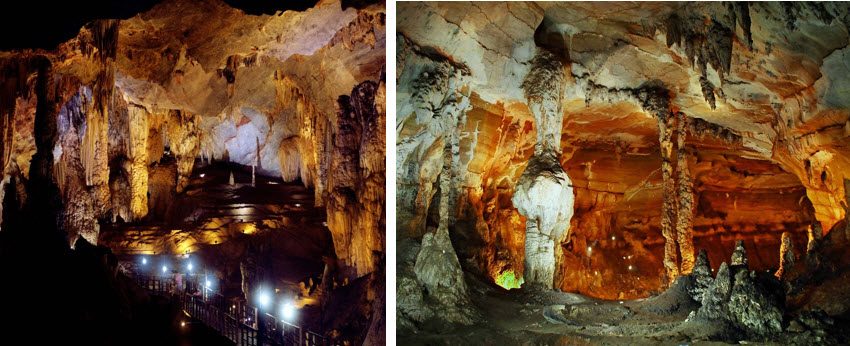
National Park Phong Nha-Ke Bang is a national park in Bo Trach, and Minh Hoa, Quang Binh, Dong Hoi City and about 50 km northwest of the capital, Hanoi, about 500 kilometers south . The park bordering nature reserve in the province Hin Namno Khammouan, Laos to the west, from the South China Sea 42 kilometers east from the border of the two countries.
In Phong Nha-Ke Bang has a network of about 300 large and small caves. Phong Nha cave system was Cave Research Association Royal (BCRA) considered valuable cave leading with 4 points most: with the longest underground river, has the highest and widest entrance, wide, sandy beaches and the most beautiful, the most beautiful stalactites .
Compared to the other three national parks have been recognized as a UNESCO World Heritage Other Southeast Asian (Gunung Mulu National Park in Malaysia, Puerto Princesa Subterranean River National Park in Palawan by the Philippines and Lorentz National Park in West Irian Indonesia) and several other karst areas in Thailand, China, Papua New Guinea, the karst in the national Park Phong Nha-Ke Bang with older age, geological structure is more complex and has multiple underground river system and more complex forms.
Over night at Muong Thanh Quang Binh
Lunch : PHONG NHA QUAN RESTAURANT
Dinner : ANH DAO RESTAURANT
DAY 7 : DONG HOI- HIEN LUONG BRIDGE ( crossing not stop car ) – HUE- HO CHI MINH :

Hien Luong Bridge across the Ben Hai River, Hien Luong village, Vinh Thanh Commune, Vinh Linh district, Quang Tri province, Vietnam. It was here, has happened to the “glare”, “fighting chance” fierce Vietnam War . At that time, Hien Luong Bridge is the frontier separating the two Koreas Vietnam (North building socialism and support for the Southern resistance, Southern by the Saigon regime backed by the United States to manage) for 21 years, from 1954 to 1975.
Tranfer to airport take domestic fly to Ho Chi Minh City. Dinner on Sai Gon River
Over night at New Pacfic Hotel / Ramana Hotel
Lunch : PHUOC THANH RESTAURANT
Dinner : SAI GON II RESTAURANT

DAY 8 : HO CHI MINH- MY THO- HO CHI MINH :
Afet breakfast transfer to My Tho,take a boat trip to visit Thoi Son island, Me Kong delta . Lunch the local restaurant with special is elephant fish, back to Ho Chi Minh city for dinner
Over night at New pacffic hotel/ Ramana hotel .
Lunch : BACH TUNG VIEN RESTAURANT
Dinner : TAU BEN NGHE CRUISE

DAY 9 : HO CHI MINH- CU CHI Tunnels – HO CHI MINH – AIRPORT :
Am tranfer to Cu Chi Tunnels ( Cu Chi Tunnels is a defense system in the ground in Cu Chi District, Ho Chi Minh City from 70 kilometers to the north-west. This system is Vietnam Ming and the National Liberation Front of South Vietnam during the war digging Indochina and Vietnam War. Tunnel system, including the clinic, many rooms, kitchen, storage, office, subway system underground. The system is about 250 km long tunnels and ventilation systems at the location of the bushes. Cu Chi Tunnels are built on land known as the “land of steel”, located at the end of the Ho Chi Minh Trail. During Tet 1968 Campaign, the National Liberation Front of South Vietnam have used the tunnel system to attack on Saigon.
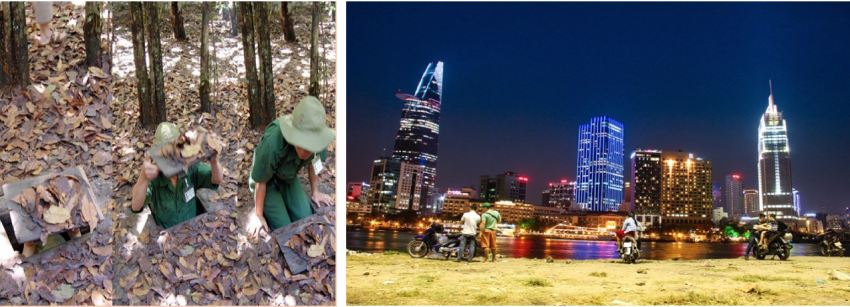
In 2015, the historic Cu Chi Tunnels received the title of Hero of Labor, especially due to outstanding achievements in labor, creativity. In 20 years of operation, the relic welcomed more than 20 million domestic and foreign tourists to visit and learn. [1]
February 12, 2016, the historic Cu Chi Tunnels to receive the rank of special national relic. Contine visit War Remnants Museum, Ben Thanh Market, Saigon Central Post Office , Saigon Notre-Dame Basilica
War Remnants Museum
This museum was founded September 4, 1975 under the name “American showrooms-masked crime”. November 10, 1990 renamed “The exhibit aggressive war crimes”. To July 4, 1995 (a week before US President Bill Clinton declared the normalization of diplomatic relations with Vietnam), this museum was renamed the “War Remnants Museum” today . War Remnants Museum exhibits some artifacts, images of the Vietnam War with the theme: American soldiers massacred, tortured, imprisoned people, spraying toxic chemicals, spraying bombs to destroy the North. The objects such as aircraft, artillery, tanks, guillotine and two “tiger cages” are built right size in Con Dao prison.
There are galleries of: southwest border war, a war to protect the northern border, the Spratly Islands issue, the plot of the hostile forces …
Outside, the museum has on display booths, product introduction ethnic culture of Vietnam, Vietnam water puppetry room.
Saigon Central Post Office (Vietnamese: Bưu điện Trung tâm Sài Gòn, French: Poste centrale de Saïgon) is a post office in the downtown Ho Chi Minh City, near Saigon Notre-Dame Basilica, the city’s cathedral. The building was constructed when Vietnam was part ofFrench Indochina in the late 19th century. It counts with Gothic, Renaissance and French influences. It was constructed between 1886-1891 and is now a tourist attraction.
It was designed by Alfred Foulhoux,[2] but is often erroneously credited as being the work of Gustave Eiffel.[1] or a collaboration between Foulhoux and Auguste Henri Vildieu
Inside the Saigon Central Post office of special note are two painted maps that were created just after the post office was built, the first one located on the left side of the building is a map of Southern Vietnam and Cambodia titled Lignes telegraphiques du Sud Vietnam et Cambodge 1892 which translates to “Telegraphic lines of Southern Vietnam and Cambodia 1892”. The second map of greater Saigon is titled Saigon et ses environs 1892 that translates as “Saigon and its surroundings 1892”.
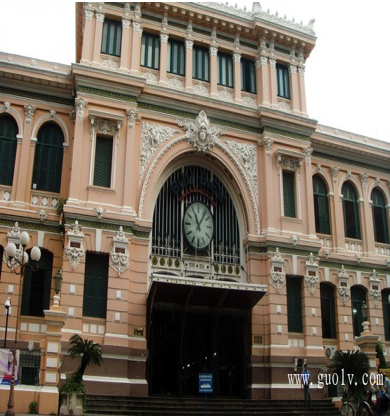 Saigon Notre-Dame Basilica (official name: the cathedral basilica of Our Lady of Immaculate Conception, in English: Immaculate Conception Cathedral Basilica, French: Cathédrale Notre-Dame de Saigon, referred to as Cathedral she) is the cathedral of the Archdiocese of Ho Chi Minh City, one of the unique architecture of Saigon, the destination of local and foreign tourists, tourist characteristics of Vietnam.
Saigon Notre-Dame Basilica (official name: the cathedral basilica of Our Lady of Immaculate Conception, in English: Immaculate Conception Cathedral Basilica, French: Cathédrale Notre-Dame de Saigon, referred to as Cathedral she) is the cathedral of the Archdiocese of Ho Chi Minh City, one of the unique architecture of Saigon, the destination of local and foreign tourists, tourist characteristics of Vietnam.
After lunch to airport for depature….. The end program !
Lunch : THAT NAM TON RESTAURANT
Dinner : X
